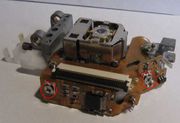CD and DVD players
This page covers CD, DVD and Blue-ray players.
Summary
An optical disk (CD, DVD or Blue-ray, and all the variants) contains a spiral track of minute pits or spots of different reflectivity. Unlike a vinyl LP, the track starts in the middle. In the case of a normal CD, the spiral if unwound would be 5.7km in length. The spots are only of the order of 1/1000mm wide, and the laser has to follow them precisely. It's hardly surprising therefore that players not infrequently fail.
Diagnosis
A visual inspection should first be undertaken. Look for dust, hairs or fluff on the lens, but never touch it with your fingers.
The lens is typically suspended on 4 thin springy wires, allowing it to be moved up and down to focus or sideways to follow the track. Several coils attached to the lens move it relative to fixed permanent magnets.
Using a small screwdriver or similar tool, very gently prod the lens to see if it moves freely, but don't move it more than a fraction of a millimetre. Check for any signs that any of the springy wires are broken or distorted. In such a case, a repair is unfortunately not normally practical.
There is usually an interlock which prevents the disk from spinning while the lid is open, which you may be able to override by pressing it with a suitable tool. You may need to partially disassemble the unit to do so.
The following should not be tried on mains powered equipment with the lid off unless you are completely sure you can do so safely. If you can override the interlock whilst turning the player on with no disk inserted, you should see the spindle start to rotate, then the lens move to a position close to the spindle. You may then see the laser come on and the lens jiggle up and down as it tries to focus on the disk. CD-only players may use an infrared laser which you won't be able to see come on, though a digital camera or camera phone may.
The previous test will show whether there are any major mechanical problems.
Repair
Dust can be removed from the lens by gently blowing, or using a very soft brush. Bits of fluff or hair may only be visible with a magnifying lens. If they won't blow or brush away, try very carefully with a fine pair of tweezers and a steady hand.
Check all electrical connections. It may be worth reseating ribbon cables in their sockets, though they rarely cause problems.
If everything looks good both mechanically and electrically but the player simply refuses to recognise disks, it may be worth adjusting the laser power. If you can gain access to the laser head, look for the laser power adjustment control. In the case of a CD/DVD or a CD/DVD/Blue-ray player there may be two separate lasers, each with its own control. Unfortunately there is no simple way to tell which is which.
Adjusting the laser power should be regarded as a last resort. If you turn it up too far you may burn out the laser or reduce its life, or you may damage recordable or re-recordable disks. Mark the original position of the control in some way so you can restore it to its original setting, then move it clockwise by just a very small amount. Then see if the player now recognises disks.
Safety
References
External links
- External links as bullet points
